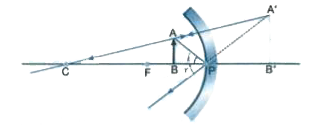The linear magnification produced by a spherical mirror is +3. Analyse this value and state the (i) type of mirror and (ii) position of the object with respect to the pole of the mirror. Draw ray diagram to show the formation of image in this case.
(i) Concave mirror
(ii) Between the pole and focus

Topper's Solved these Questions
- BOOK - VK GLOBAL PUBLICATIONCHAPTER - LIGHT-REFLECTION AND REFRACTIONEXERCISE - SHORT ANSEWR QUESTIONS-II12videos
LIGHT-REFLECTION AND REFRACTION
- BOOK - VK GLOBAL PUBLICATIONCHAPTER - LIGHT-REFLECTION AND REFRACTIONEXERCISE - LONG ANSWER QUESTIONS3videos
LIGHT-REFLECTION AND REFRACTION
- BOOK - VK GLOBAL PUBLICATIONCHAPTER - LIGHT-REFLECTION AND REFRACTIONEXERCISE - VERY SHORT ANSEWR QUESTIONS61videos
LIGHT-REFLECTION AND REFRACTION
- BOOK - VK GLOBAL PUBLICATIONCHAPTER - ELECTRICITYEXERCISE - SOME IMPORTANT NUMERICALS12videos
ELECTRICITY
- BOOK - VK GLOBAL PUBLICATIONCHAPTER - MAGNETIC EFFECTS OF ELECTRIC CURRENTEXERCISE - HOTS (Higher Order Thinking Skills)22videos
MAGNETIC EFFECTS OF ELECTRIC CURRENT
Similar Questions
Draw a ray diagram showing the formation of image of a point object by a plane mirror.
View SolutionA spherical mirror produces an image of magnification -1 on a screen placed at a distance of 50 cm from the mirror.
(a) Write the type of mirror.
(b) Find the distance of the image from the object.
(c) Draw the ray diagram to show the image formation in this case.View SolutionFig. shows a concave mirror with its pole at P, focus F and centre of curvature C. Draw ray diagram to show the formation of image of an object OA.
 View Solution
View SolutionWhere would the image be formed by a convex mirror if the object is placed :
(a) between infinity and pole of the mirror ?
(b) at infinity ?
Draw labelled ray-diagreams to show the formation of image in both the cases.View SolutionIn the given figure below, AB is the object and CD is its image. If a spherical mirror is used to get the image, name the type of spherical mirror used and locate the position of focus of the mirror by drawing a ray diagram. 'P' is the pole of the mirror.
 View Solution
View SolutionIt is desired to obtain an erect image of an object, using concave mirror of focal length of 12 cm.
(i) What should be the range of distance of an object placed in front of mirror ?
(ii) Will the image be smaller or large than the object ? Draw a ray diagram to show the formation of image in this case.
(iii) Where will the image of this object be, if it is placed 24 cm in front of the mirror ? Draw a ray diagram for this situation also to justify your answer.
Show the positions of the pole, the principal focus and the centre of curvature in the above ray diagrams.View SolutionIt is desired to obtain an erect image of an object, using concave mirror of focal length of 12 cm.
(i) What should be the range of distance of an object placed in front of mirror ?
(ii) Will the image be smaller or large than the object ? Draw a ray diagram to show the formation of image in this case.
(iii) Where will the image of this object be, if it is placed 24 cm in front of the mirror ? Draw a ray diagram for this situation also to justify your answer.
Show the positions of the pole, the principal focus and the centre of curvature in the above ray diagrams.View SolutionIt is desired to obtain an erect image of an object, using concave mirror of focal length of 12 cm.
(i) What should be the range of distance of an object placed in front of the mirror?
(ii) Will the image be smaller or larger than the object. Draw ray diagram to show the formation of image in this case.
(iii) Where will the image of this object be, if it is placed 24 cm in front of the mirror? Draw ray diagram for this situation also to justify your answer. Show the positions of pole, principal focus and the centre of curvature in the above ray diagrams.View SolutionWhat is the minimum number of rays required for locating the image formed by a concave mirror for an object ? Draw a ray diagram to show the formation of a virtual image by a concave mirror.
View SolutionDraw ray diagram to show formation of magnified real image of an object by a concave mirror.
View Solution

